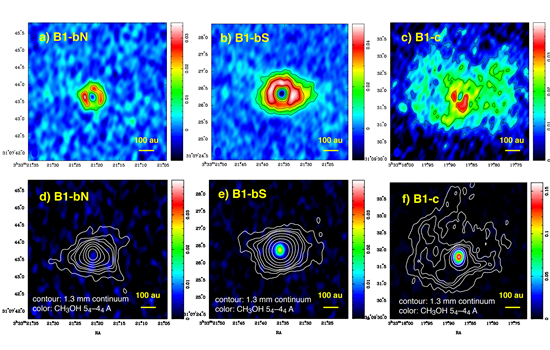Research Gallery > Star Formation Studies
Research Gallery
Star Formation Studies
| ALMA revealed the earliest stage of protostellar evolution |
|
Image Credit: N.Hirano

Three extremely young low-mass protostars, B1-bN, B1-bS, and B1-c, observed with the ALMA at a resolution of ~0.2" (= 47 au). The upper panels show the images of C17O 2-1 emission, the lower panels show the methanol images (color) overlaid on the 1.3 mm continuum images (white contours).
|
| At the very beginning of star formations, newly born object is surrounded by a dense gas envelope with little CO in the gas phase. As the newly formed object warms up the gas in its close vicinity above 20–25 K, the CO starts to sublimate. The CO sublimation radius expands as the central object evolves. At the same time, the region with higher temperature (> 100 K) also expands, resulting in the sublimation of organic molecules such as methanol. Our ALMA observations with a resolution of ~0.2" (47 au) successfully revealed the evolutionary sequence of three extremely young objects using the sublimation radii of CO and methanol. B1-bN (left) having a smallest CO sublimation radius (~60 au) without methanol emission is considered to be in the earliest evolutionary stage. B1-bS (middle) having a CO sublimation radius of ~120 au and methanol emission at the center is in the later evolutionary stage than B1-bN. However, B1-bS is still younger than Class 0 protostar B1-c (right) with extended C17O (CO) emission and bright methanol emission. |
 asiaa.sinica.edu.tw Media Request: epo
asiaa.sinica.edu.tw Media Request: epo asiaa.sinica.edu.tw
asiaa.sinica.edu.tw 
